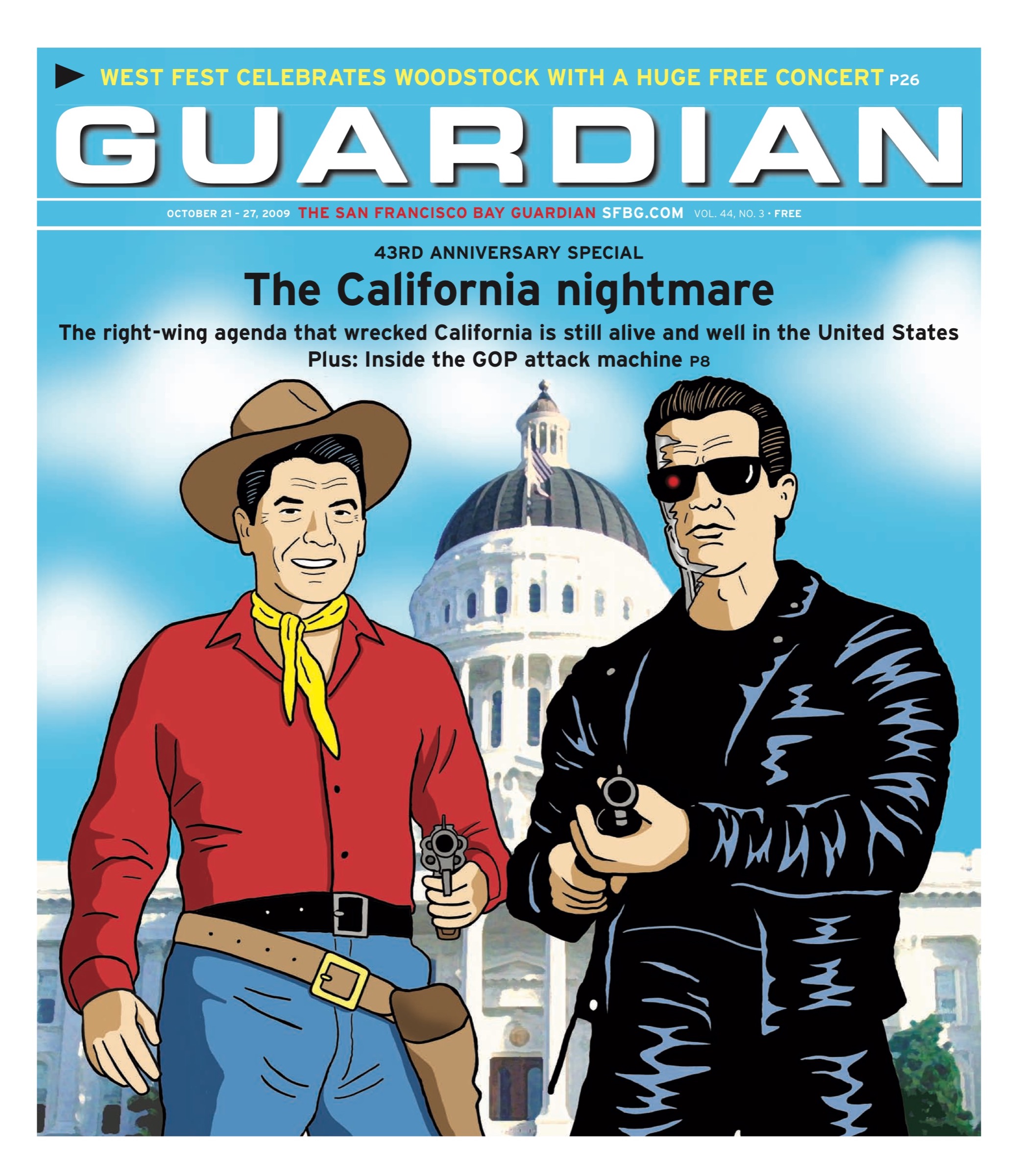news@sfbg.com
In the middle of what economists are calling the worst economic downturn since the Great Depression, when California unemployment rates have hit post-WWII records, commercial defaults are rising, and families and businesses are hurting, Pacific Gas and Electric Co. is asking for electricity rate hikes that would take at least $47 million out of the local community, a Guardian analysis shows. By some estimates, the impact could be has high as $787 million.
And the economy is already losing between $174 million and $483 million a year because the city hasn’t created a public power system. So the total impact on the San Francisco economy of paying PG&E’s high private rates could total $2.8 billion. That’s money that local residents can’t spend on good and services, local businesses can’t use to hire more workers and city government can’t collect taxes on.
The analysis is based on work done in 2002 by Irwin Kellner, chief economist for Marketwatch and a former economics professor at Hofstra University. Kellner analyzed the savings to the Long Island economy after that community replaced a private utility with a public power system (see "The $620 million shakedown, 9/4/2002).
It’s not a complicated set of calculations.
During the fiscal year ending in 2009, San Francisco residents and businesses paid $644 million on electricity, according to data from the city’s Controller’s Office. If PG&E’s proposed 6.5 percent average rate hike is approved for 2011 (with additional hikes of 1.4 percent and 1.1 percent the following two years) that number would ultimately rise to $704.5 million.
Over the next four years, as those rate hikes kick in, San Franciscans would be handing PG&E an extra $157 million. That’s $106 million businesses won’t have to pay employees or make capital improvements, and $51.3 million consumers won’t have to spend in local businesses.
"That’s $51 million less that would otherwise go into San Francisco neighborhood businesses," said Ted Egan, chief economist in the city’s Office of Economic Analysis. "Instead the $51 million goes to PG&E, and they won’t spend it all in San Francisco. Some will go to shareholders and outside the region, so the rate hike would end up having a larger impact than the initial $51 million."
That "larger impact" is called the multiplier effect: if you give one dollar to someone likely to spend it locally, he or she will buy shoes at a local shoe store, whose owner will use the dollar to buy groceries at the local grocery store, whose owner will pay the counter worker, who will spend the money on paint at the local hardware store — and by the time it’s circulated through the local economy, that dollar has created far more than a dollar’s worth of economic activity.
Economists argue on how to figure the exact impact of that dollar. Kellner has done studies of the economic impact of utility rates and estimates the multiplier — the economic impact of electricity rate hikes — to be five, expanding the $157.4 million to over $787 million.
Egan takes a more conservative view of the San Francisco economy and consumer spending. He estimates that the multiplier for utility rate hikes is closer to 0.3 — or slightly higher when commercial rates are factored in. According to his estimate the impact would be closer to $47,231,083.86.
The multiplier suggested by federal government economists during the stimulus bill discussion is 1.8, the number cautiously posited by Cynthia Kroll, senior regional economist for the Fisher Center for Real Estate and Urban Economics at UC Berkeley. Based on her calculations, PG&E would be yanking $283 million out of the local economy.
Either way, it’s a huge sum of money, particularly in a bad economy.
A PATTERN OF RATE HIKES
This latest rate hike, Mindy Spatt, communications director of the Utility Reform Network told us, is only part of a pattern of attempts by PG&E to raise rates. Every three years, utility companies present a general rate case to the California Public Utilities Commission. But Spatt said utilities can come to the PUC in between to ask for other rate hikes.
"They’re constantly coming back to the commission for this that and the other thing," she said. "[PG&E] came back after they got money for smart meters to get money for smarter meters.
"Overall, the pattern is that rates continue to go up," she continued. "The only other thing going up is executive compensation. We are still plagued with blackouts, we still get crappy service."
She’s right: data from other local utilities show that PG&E rates are anywhere from 20 percent to 40 percent higher than cities that have public power. PG&E would like its customers to believe that higher rates will improve service and reliability — but that’s not what’s happening.
"They don’t spend the money on giving us good service, instead [they focus] on convincing us they are giving us good service," Spatt said.
In its announcement of the proposed hike, PG&E claimed the rate hikes are to maintain infrastructure and reliability. A further $1.1 billion is also being asked for as part of a Cornerstone Improvement Project to increase reliability.
"Reliability" is an old battle horse trotted out every few years as the justification for rate hikes. PG&E is consistently less reliable than other local utilities and even less reliable than other large private utilities. So the company constantly asks for money to upgrade its system — except that reliability doesn’t seem to improve much, and it hasn’t improved much in the past decade, according to California Public Utilities Commission data.
"It’s interesting to compare their rates to municipal utilities and how much higher they are," Spatt said. "What do we get for the extra money we pay? Because by most measures they’re not doing a great job."
In fact, Guardian research shows that local municipal utilities have consistently better reliability records than PG&E (see "The blackout factor," 8/5/09).
PUBLIC POWER SAVINGS
The direct cost of PG&E’s high rates costs the local economy — and those losses are compounded by the money that could have been saved with public power.
A detailed Guardian analysis concluded last year that San Francisco would be able to cut electric rates by 15 percent if it ran its own utility (see "Cleaner and cheaper," 9/10/2008). That’s an entirely reasonable estimate, according to Jeff Shields, general manager of the South San Joaquin Irrigation District, which is fighting with PG&E to take over electricity distribution in its service area. He projects similar savings for his customers.
Shields thinks his system (and one in San Francisco) could cut rates even further. As nonprofit, he explained, SSJID can save money in multiple areas and pass those savings onto customers.
"We don’t pay taxes on earnings," he told us. "PG&E, as a shareholder company, can collect an 11.45 percent margin of profit. We don’t pay that. We don’t have the same overhead. We don’t have high-rises or corporate jets."
Public power agencies pay less to borrow money, are eligible for tax-exempt financing, typically have a higher credit rating and often keep a substantial cash reserve.
"[Selling electricity] will continue to produce substantial income," he said. "As a nonprofit, the only thing we can do with that income is continue to drop rates."
Other municipal utilities, like Silicon Valley Power in Santa Clara, have been able to keep rates low as PG&E has continued to raise rates. Larry Owens, customer services manager at SVP, said its residential rates are half of PG&E’s, and less for larger users.
The opportunity cost of not having municipal power — factoring in PG&E’s proposed rate hike and the assumption, based on Guardian and SSJID analyses, that rates would be lowered by at least 15 percent — is approximately $545 million over the next four years. Theoretically, that money could have resulted in a $980 million to $2.8 billion bump in the local economy.
This doesn’t include what some municipal utilities call "general fund transfers" or money that goes directly into a city’s piggy bank to be spent on libraries, schools, public health, and other services.
"Private sector utilities pay money to shareholders," said Joyce Kinnear, utility marketing services manager in Palo Alto. "We give these payments to the general fund to give services to local residents."
In Palo Alto’s case, this amounts to more than $9.25 million annually, or 9 percent of annual sales revenue, according Ipek Connolly, senior resource planner for the Palo Alto Utilities Department. Alameda Municipal Power’s Alan Hanger says AMP pays at least $4.2 million into city coffers. Silicon Valley Power, according to Owens, sends 5 percent of its revenue back to the city in the form of $12.92 million.
Shields, at SSJID, said the utility plans to give 4 percent of revenue to a public benefits program for "various social services, conservation, and energy efficiency programs." This, in addition to general fund transfers, constitutes a direct contribution to the community 50 percent larger than PG&E’s.
"Public power systems provide a direct benefit to their communities in the form of payments and contributions to state and local government," Nicholas Braden, director of communications at the American Public Power Association, told us. "The total value of the contributions made by the publicly-owned utilities often comes in many forms and is not always easily recognized. In addition to payments such as taxes, payments in lieu of taxes, and transfers to the general funds, many of the utilities make other contributions in the form of free or reduced cost services provided to states and cities."
San Francisco has a 7.5 percent utility user tax, but the tax is only levied on homes and businesses. In other words, PG&E takes hundreds of millions out of the local economy — and gives back nothing.
————-
HOW SF COULD LOSE $2.8 BILLION
Amount San Franciscans paid for electricity IN 2009: $644 million
Additional cost of PG&E rate hike (per year): $157 million
Multiplier (maximum estimate): $787 million
Reduction in costs under public power: $483 million
Multiplier: $2.1 billion
Total impact of high PG&E rates: $2.87 billion
SOURCE: Guardian research based on public records
————
RATE HIKES HIT THE POOR HARDEST
Pacific Gas and Electric Co. estimates that its current rate hike proposal will add between $2.23 and $16.76 per month to an average residential electricity bill. That may not seem huge — but it adds up.
"Each rate hike in and of itself isn’t that much money," acknowledges Mindy Spatt of the Utility Reform Network (TURN). "But overall, rates are very high."
And if you’re in one of the 24,000 San Francisco families that, according to U.S. census data, livie in poverty, even the smallest increase in utility bills can have serious ramifications.
"A few dollars here, and a few there can really affect low-income households," said Stephanie Chen, legal fellow at the Greenlining Institute, a public policy research and advocacy group. "It can mean the difference between ‘Do I pay the power bill, or do I buy groceries?’"
Utility bills are not a discretionary expense, and, as unemployment continues to rise and adjustable rate mortgages continue to adjust upward, more households are finding themselves squeezed on all sides. Depending on timing and cash flow, Chen said it would be easy to imagine a formerly stable household unable to pay the utility bill.
And if a household can’t pay the bill for two weeks, PG&E sends a notice of termination and shuts off power. According to Spatt, PG&E shuts off 15,000 households in its service area each month.
"Rate hikes are certainly not going to bring down that number," she said. "These are not people who can’t pay for a Mercedes and got it repossessed. They are people who are losing heat, electricity, the ability to cook."
To turn the power back on, PG&E requires a deposit of twice the average bill to reestablish credit. If a household can’t pay its regular bill, paying twice the amount is even harder.
Spatt says TURN is working to push the CPUC to do something about this and help consumers who are struggling. Chen says utility companies already know their customers are hurting during the recession.
"All the utilities are facing decaying infrastructure concerns and renewable energy goals," Chen said. "They are facing increased costs, which they pass on to ratepayers. We know rate increases are inevitable — but we want to make sure they are necessary and cost-effective."










